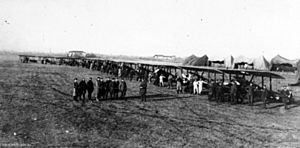Alan Rice-Oxley facts for kids
Quick facts for kids
Alan Rice-Oxley
|
|
|---|---|
| Birth name | Alan Rice Oxley |
| Born | 1 July 1896 Kings Langley, Hertfordshire, England |
| Died | 21 July 1961 (aged 65) |
| Buried |
St Mary Magdalene churchyard, Loders, Dorset, England
(50°44′44.8″N 2°43′19.6″W / 50.745778°N 2.722111°W) |
| Allegiance | United Kingdom |
| Service/ |
British Army Royal Air Force |
| Years of service | 1914–1921 |
| Rank | Lieutenant |
| Unit |
|
| Battles/wars | First World War • Western Front • Italian Front |
| Awards | Distinguished Flying Cross |
| Other work | Police officer, North Borneo Farmer, Dorset |
Lieutenant Alan Rice-Oxley (born July 1, 1896 – died July 21, 1961) was a brave British pilot during World War I. He became a special kind of pilot called a flying ace in 1918. This means he shot down six enemy aircraft in air battles.
Contents
Early Life and Education
Alan Rice-Oxley was born in Kings Langley, Hertfordshire, England. His birthday was July 1, 1896. His parents were Edward Charles Rice Oxley and Emily Armstrong.
He went to school at Watford Grammar School for Boys. He studied there from January 1908 until July 1914.
Military Service in World War I
Alan Rice-Oxley first joined the army as a private soldier. He was part of the London Regiment. In February 1915, he became a second lieutenant in the King's Shropshire Light Infantry.
Becoming a Pilot
In September 1916, he joined the Royal Flying Corps. This was the air force of Britain at the time. He trained to become a pilot. His first job was with No. 15 Squadron in France. He helped spot enemy artillery and gathered information from the air.
During the Battle of the Somme in October 1916, he was hurt. After he got better, he became a fighter pilot. On July 1, 1917, he was promoted to lieutenant.
Flying Ace on the Italian Front
In 1918, Lieutenant Rice-Oxley joined No. 45 Squadron. This squadron flew Sopwith Camel planes. They were fighting on the Italian Front.
He achieved his first victories on July 12, 1918. He and Captain Cedric Howell faced many Austro-Hungarian planes. They were near the town of Feltre. In the air battle, Rice-Oxley bravely destroyed two enemy planes. For his courage, he received the Distinguished Flying Cross.
Over the next three days, he shot down another enemy plane. He also forced two more planes to crash. On August 16, he became a flight commander. He earned his sixth and final victory on August 22.
After the war, Rice-Oxley left the Royal Air Force in March 1919. He also left the King's Shropshire Light Infantry in September 1921.
Life After the War
In 1921, Alan Rice-Oxley moved to North Borneo. He became a police officer there. The next year, he was appointed as an officer with the rank of captain.
Adventures in North Borneo
His job included showing important visitors around. In 1926, he was driving with a famous writer, Somerset Maugham. They saw a very long snake, about 13 feet (4 meters) long. Rice-Oxley bravely killed the snake using his walking stick.
In 1929, he became the Superintendent of Police and Prisons in Jesselton. He continued to rise in his career. Eventually, he became the Commissioner of Police. On November 12, 1936, he officially changed his name to Alan Rice-Oxley.
Marriage and World War II
In early 1937, he married Valerie Helen Gardner. She was the widow of another former RAF officer. In May 1937, they sailed from London on a ship called the SS Ranchi.
When World War II began, they returned to England. Later in the war, Valerie stayed in England. Rice-Oxley went back to North Borneo.
Internment and Later Years
From 1942 to 1945, Rice-Oxley was held by the Japanese. He was a civilian prisoner at Batu Lintang camp in Sarawak.
After the war, he returned to Britain. He became a dairy farmer in Dorset. Alan Rice-Oxley passed away on July 21, 1961. He is buried in the churchyard of St. Mary Magdalene in Loders, Dorset.
Honours and Awards
Distinguished Flying Cross
Lieutenant Alan Rice-Oxley received the Distinguished Flying Cross. This award is given for bravery in air combat.
The award citation said: "This officer, with another plane, attacked fifteen enemy aircraft. He quickly destroyed two of them. He then kept attacking the remaining thirteen planes. The battle ended with six enemy planes destroyed and one forced to crash. Two days later, he destroyed two more enemy aircraft. The bravery shown by this officer, and his companion, Captain C. E. Howell, in attacking fifteen machines, was truly outstanding."


